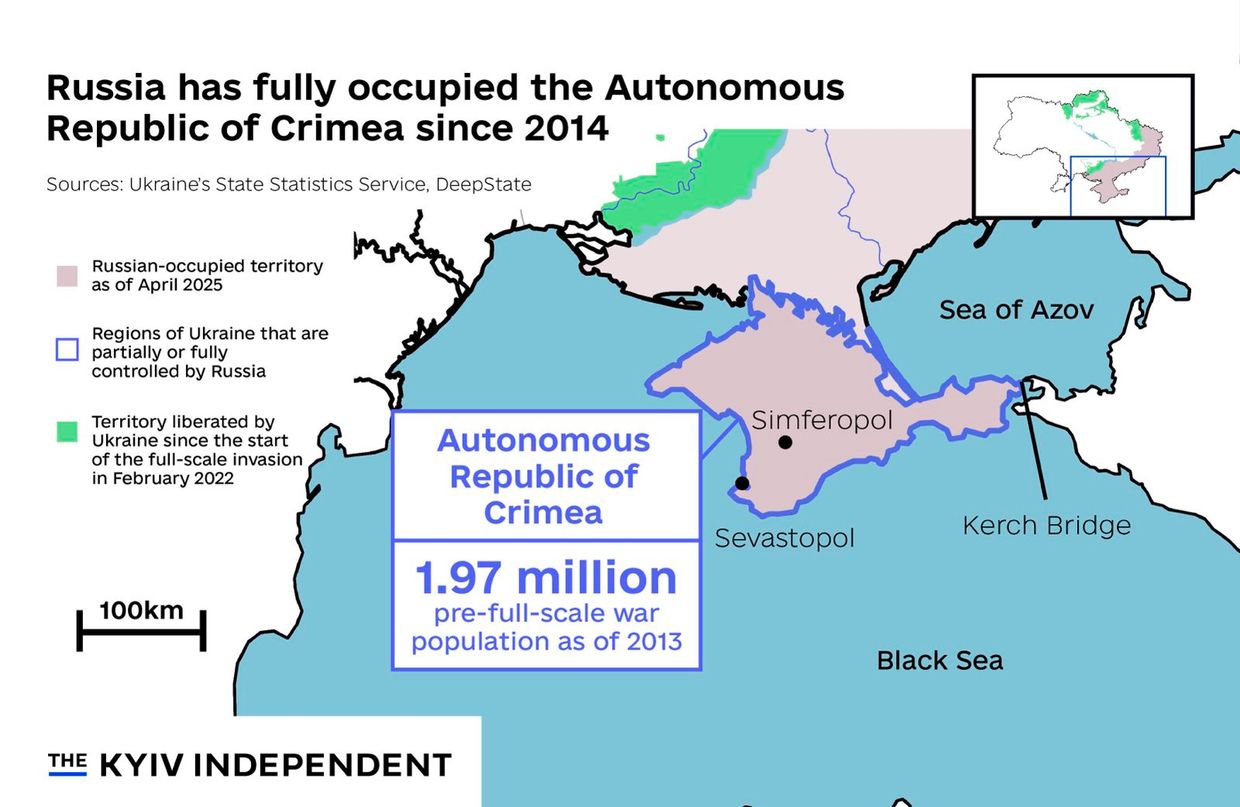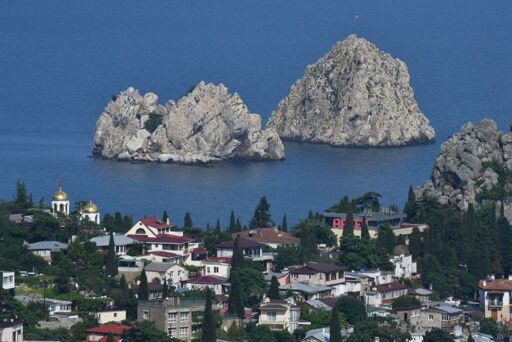U.S. President Donald Trump referred to Crimea as a piece of land “right in the ocean” that is “the size of Texas” while talking on the Mark Levin Show, a right-wing talk radio program, on Aug. 20.
“It’s beautiful. It’s, you know, this massive piece of land stuck out right in the ocean, right in the Black Sea. So beautiful. I mean, it’s so beautiful,” he told Levin, before adding that Ukraine was told by former U.S. President Barack Obama to “give it up to Russia.”
Russia invaded Ukraine’s Crimean Peninsula in February 2014 amid the deadliest days of the EuroMaidan Revolution that eventually ousted Ukraine’s pro-Russian President Viktor Yanukovych. Around 30,000 Russian troops crossed into Crimea, taking hold of the peninsula by early March 2014 and soon declaring its illegal annexation.
At the time, Russia’s annexation of Crimea represented the largest seizure of land in Europe since World War II — now second only to Russia’s 2022 full-scale invasion of Ukraine.
Here’s what you need to know about Crimea and Russia’s ongoing occupation.
Crimea is the size of Massachusetts, not Texas
Crimea is roughly 26 times smaller than Texas and is not located “in the middle of the ocean” — it is a peninsula in the Black Sea, around 27,000 square kilometers (10,400 square miles) in size. It is roughly the same size as the U.S. state of Massachusetts or the country of Haiti.
Texas, meanwhile, is a little over 10% larger than the entire territory of Ukraine.
Crimea is connected to Ukraine by land to the north, where it meets Kherson Oblast, which Russia has partially occupied since 2022. As well as the Black Sea, the peninsula lies on the western shores of the Sea of Azov.
 ukraine map2025 crimea.jpeg
ukraine map2025 crimea.jpeg
The only access from Russia to Crimea is via the Kerch Bridge, a 19-kilometer (12-mile) bridge built by Moscow after Russia annexed the peninsula. The bridge is a highly strategic (and illegal) construction that Ukraine regularly targets due to its role as a critical transport route for Russian forces to occupied Ukrainian territories.
The bridge suffered significant damage in Ukrainian attacks in October 2022 and July 2023. On June 3, Ukraine’s Security Service (SBU) confirmed it had carried out a third strike targeting the bridge, detonating 1,100 kilograms of explosives beneath its underwater supports.
Read also: The 2014 annexation of Crimea — How Russia stole Ukraine’s peninsula
Russia illegally annexed Crimea in 2014 — but its preparations started long before then
After Russia moved its forces into Crimea in early 2014, Moscow swiftly held a sham referendum in the absence of any international observers and with armed Russian soldiers present at polling locations. Russian occupation authorities claimed that 97% of voters were in favor of annexation.
While Trump blamed Obama on the Mark Levin show for Russia’s annexation, in April 2025, he questioned why Ukraine “didn’t fight” for Crimea.
“Why didn’t they fight for it eleven years ago when it was handed over to Russia without a shot being fired?” he wrote on his Truth Social platform on April 23.
There are multiple reasons why Russia was able to take Crimea so easily. Foremost among them is that Moscow had been building up its military in the region for years, meaning that Russian military strength exceeded that of Ukraine’s in Crimea.
The Kremlin had been amassing troops in Crimea for years thanks to agreements with Ukraine’s pro-Russian President Yanukovych that allowed it to station its Black Sea Fleet on the peninsula and move its troops around without restrictions. It also covertly brought modernized or refurbished equipment into Crimea between 2010 and 2014, according to Ukraine’s military intelligence (HUR).
Russia also timed its annexation at the moment of a volatile political crisis in Kyiv in March 2014, at the conclusion of the EuroMaidan Revolution, leaving Kyiv unable to organize a defense of the peninsula.
At the same time, the U.S. and the U.K. — signatories of the 1994 Budapest Memorandum, which pledged to uphold Ukraine’s territorial integrity in exchange for Kyiv surrendering its nuclear arsenal — did not come to Ukraine’s defense.
Read also: Could Ukraine have stopped Russia’s illegal annexation of Crimea in 2014?
Crimea is the historic home of Crimean Tatars
While Russia claims that Crimea is Russian, the native inhabitants of Crimea are Crimean Tatars, the peninsula’s indigenous people and a national minority of Ukraine. Their history is marked by centuries of conflict and repression at the hands of Moscow, something that has only continued under Russian occupation to this day.
Before the Russian Empire conquered Crimea in 1783, Crimean Tatars made up the vast majority of the population. In 1785, Russians only made up about 2.2% of the population of Crimea.
Due to centuries of oppression of Crimea’s native population, Russians comprised 74.4% of Crimea by the end of the Soviet Union. The greatest blow to the indigenous population came in 1944, when the Soviets falsely accused the entire Crimean Tatar people of collaborating with Nazi Germany, which occupied Crimea for two years.
Up to 200,000 Crimean Tatars – mostly women, children, and the elderly – were deported to Central Asia and Siberia on Soviet dictator Joseph Stalin’s orders.
Crimean Tatars were only able to return to their homeland 40 years later. Among them were the families of well-known Ukrainians, including former defense minister Rustem Umerov and singer Jamala.
Ukraine, as well as countries including the Netherlands, Lithuania, Latvia, and Canada, recognize the 1944 deportation of Crimean Tatars as genocide.
Read also: Who are the Crimean Tatars?
Russia has continued to militarize Crimea
“It’s so beautiful,” Trump repeatedly told Levin on Aug. 20, a statement all Ukrainians would likely agree with. As well as being the homeland of Crimean Tatars, the peninsula was an immensely popular summer vacation destination for generations of Ukrainians.
Among Ukrainians, Crimea evokes memories of carefree vacations, time spent with family, and peace. Now, Russia has transformed Crimea into a strategic base for supporting the occupation of other Ukrainian territories.
Areas that were once popular vacation destinations have now been converted into military bases for Russian soldiers. Over 10 years of Russian occupation, the local economy also shifted toward the military-industrial complex, with Russia reviving Soviet-era military factories.
A representative of the Crimean Combat Seagulls, a Ukrainian resistance movement active on the peninsula, who spoke on condition of anonymity, recently told the Kyiv Independent that Russia’s militarization of Crimea has only accelerated since the start of the full-scale invasion in February 2022.
“Crimea currently serves two functions: as a springboard for potential offensive operations and as a base for supplying Russian forces in southern Ukraine.”
Read also: How has Crimea changed after 10 years of Russian occupation?
Recognizing Crimea as Russian violates international and Ukrainian law
The U.S. was reportedly considering recognizing Crimea as Russian in April 2025 — a move that would violate international law.
Russia’s annexation in 2014 was widely condemned and dismissed by the U.S., the EU, and most members of the U.N. The U.S. and EU responded by imposing asset freezes, travel bans, and other sanctions on various Russian officials involved in the military occupation.
During his first term in office, Trump even reaffirmed the U.S.’s opposition to Russia’s illegal annexation of Crimea by adopting the Crimea Declaration.
Issued by then-Secretary of State Mike Pompeo, the declaration stated that the U.S. “rejects Russia’s attempted annexation of Crimea and pledges to maintain this policy until Ukraine’s territorial integrity is restored.”
If the U.S. ever decided to recognize Crimea as part of Russia, it would also be impossible for Kyiv to agree to or condone such a move.
According to Ukraine’s constitution, Crimea is a legally recognized and inseparable part of Ukraine, and no acts can be passed by the Ukrainian government that contradict it. Ukraine’s constitution also can’t be changed during martial law.
From The Kyiv Independent - News from Ukraine, Eastern Europe via this RSS feed


